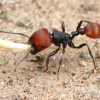The reason I am asking this question is because I am going on a trip to Refugio Sate Beach in early-mid April, and there is a high chance of finding C. vicinus queens in the mountains East of it. I have looked online to attempt to find definitive answers, to my question, but I was unsuccessful. I would like to know if any of you have had a high rate of success with raising this species in a polygenic fashion. All answers will be greatly appreciated.
-NickAnter

















